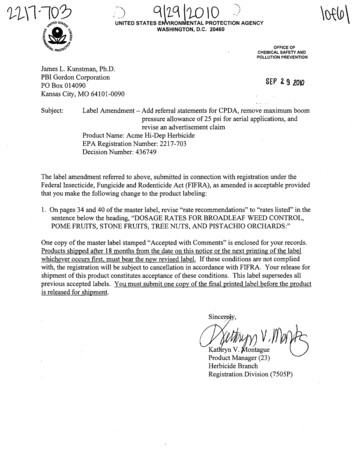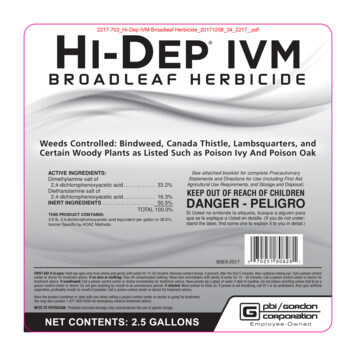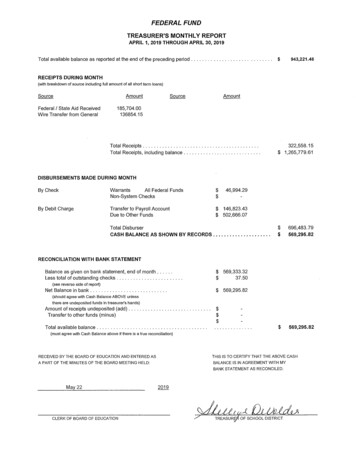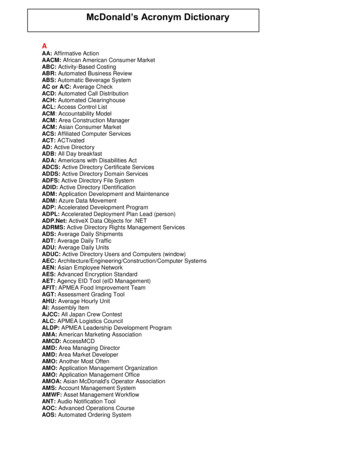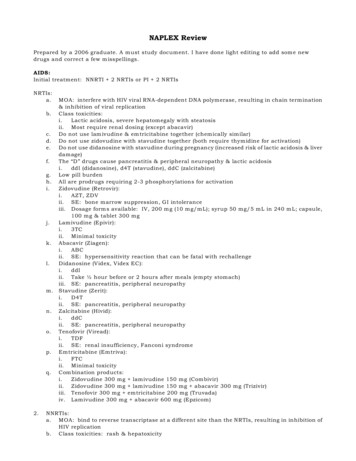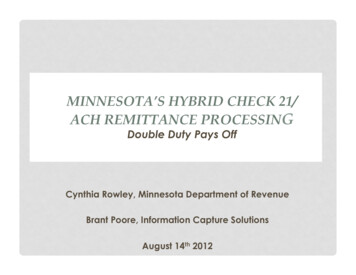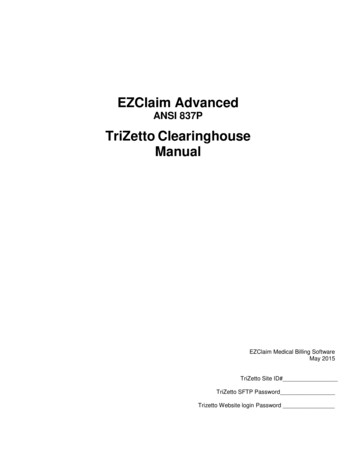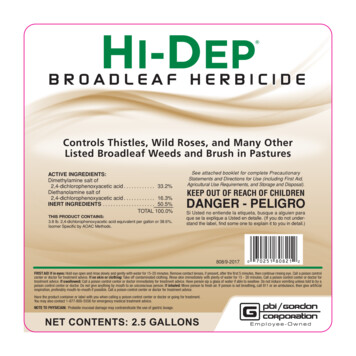
Transcription
Hi-Dep (808) 2.5-G Front Label (9-2017).pdf19/8/177:58 AMHI-DEP Controls Thistles, Wild Roses, and Many OtherListed Broadleaf Weeds and Brush in PasturesACTIVE INGREDIENTS:Dimethylamine salt of2,4-dichlorophenoxyacetic acid . . . . . . . . . . . . 33.2%Diethanolamine salt of2,4-dichlorophenoxyacetic acid . . . . . . . . . . . . 16.3%INERT INGREDIENTS . . . . . . . . . . . . . . . . . . . . 50.5%TOTAL 100.0%THIS PRODUCT CONTAINS:3.8 lb. 2,4-dichlorophenoxyacetic acid equivalent per gallon or 38.6%.Isomer Specific by AOAC Methods.See attached booklet for complete PrecautionaryStatements and Directions for Use (including First Aid,Agricultural Use Requirements, and Storage and Disposal).KEEP OUT OF REACH OF CHILDRENDANGER - PELIGROSi Usted no entiende la etiqueta, busque a alguien paraque se la explique a Usted en detalle. (If you do not understand the label, find some one to explain it to you in detail.)808/9-2017FIRST AID If in eyes: Hold eye open and rinse slowly and gently with water for 15-20 minutes. Remove contact lenses, if present, after the first 5 minutes, then continue rinsing eye. Call a poison controlcenter or doctor for treatment advice. If on skin or clothing: Take off contaminated clothing. Rinse skin immediately with plenty of water for 15 - 20 minutes. Call a poison control center or doctor fortreatment advice. If swallowed: Call a poison control center or doctor immediately for treatment advice. Have person sip a glass of water if able to swallow. Do not induce vomiting unless told to by apoison control center or doctor. Do not give anything by mouth to an unconscious person. If inhaled: Move person to fresh air. If person is not breathing, call 911 or an ambulance, then give artificialrespiration, preferably mouth-to-mouth if possible. Call a poison control center or doctor for treatment advice.Have the product container or label with you when calling a poison control center or doctor or going for treatment.You may also contact 1-877-800-5556 for emergency medical treatment advice.NOTE TO PHYSICIAN: Probable mucosal damage may contraindicate the use of gastric lavage.NET CONTENTS: 2.5 GALLONS6.5 x 6.5 inchesBLACK348465DIE
18021 - Hi-Dep (808) 2.5-G ETL Booket (9-2017).qxp 9/19/17 1:35 PM Page 15.75 x 6.25 inchesBLACK348465
18021 - Hi-Dep (808) 2.5-G ETL Booket (9-2017).qxp 9/19/17 1:35 PM Page 2Controls Thistles, Wild Roses, and Many OtherListed Broadleaf Weeds and Brush in PasturesACTIVE INGREDIENTS:Dimethylamine salt of 2,4-dichlorophenoxyacetic acid. 33.2%Diethanolamine salt of 2,4-dichlorophenoxyacetic acid . 16.3%INERT INGREDIENTS . 50.5%TOTAL 100.0%This Product Contains:3.8 lbs. 2,4-dichlorophenoxyacetic acid equivalent per gallon or 38.6%.Isomer Specific By AOAC Methods.KEEP OUT OF REACH OF CHILDRENDANGER - PELIGROSi Usted no entiende la etiqueta, busque a alguien para que se la explique a Usted en detalle. (If you donot understand the label, find someone to explain it to you in detail.)KEEP FROM FREEZING–2–
18021 - Hi-Dep (808) 2.5-G ETL Booket (9-2017).qxp 9/19/17 1:35 PM Page 3READ THE ENTIRE LABEL FIRST.OBSERVE ALL PRECAUTIONS ANDFOLLOW DIRECTIONS CAREFULLY.PRECAUTIONARY STATEMENTSHazards To Humans And Domestic AnimalsDANGER: Corrosive. Causes irreversible eye damage. Harmful if swallowed. Harmful if absorbed throughskin. Harmful if inhaled. Do not get in eyes or on clothing. Avoid contact with skin. Avoid breathing spraymist or vapor.Personal Protective Equipment (PPE)Some materials that are chemical-resistant to this product are natural rubber, natural rubber blends andlaminates. If you want more options, follow the instructions for category A on an EPA chemical-resistancecategory selection chart.All mixers, loaders, applicators, flaggers, and other handlers must wear: protective eyewear, long-sleeved shirt and long pants, shoes and socks, chemical-resistant gloves when applying with any handheld nozzle or equipment, mixing or loading,cleaning up spills or equipment, or otherwise exposed to the concentrate. chemical-resistant apron when mixing or loading, cleaning up spills or equipment, or otherwise exposedto the concentrate.See engineering controls for additional requirements.User Safety RequirementsFollow manufacturer’s instructions for cleaning/maintaining PPE. If no such instructions for washables exist,use detergent and hot water. Keep and wash PPE separately from other laundry.Engineering Control StatementsEngineering Controls for aerial application: When handlers use enclosed cabs or aircraft in a manner thatmeets the requirements listed in the Worker Protection Standard (WPS) for agricultural pesticides [40 CFR170.240(d)(4-6)], the handler PPE requirements may be reduced or modified as specified in the WPS.Pilots must use an enclosed cockpit that meets the requirements listed in the WPS for agriculturalpesticides [40 CFR 170.240(d)(6)].User Safety Recommendations Users should wash hands before eating, drinking, chewing gum, using tobacco, or using the toilet. Users should remove clothing/PPE immediately if pesticide gets inside. Then wash thoroughly and puton clean clothing. If pesticide gets on skin, wash immediately with soap and water. Users should remove PPE immediately after handling this product. Wash the outside of gloves beforeremoving. As soon as possible, wash thoroughly and change into clean clothing.–3–
18021 - Hi-Dep (808) 2.5-G ETL Booket (9-2017).qxp 9/19/17 1:35 PM Page 4First AidIf in eyes: Hold eye open and rinse slowly and gently with water for 15 - 20 minutes. Removecontact lenses, if present, after the first 5 minutes, then continue rinsing eye. Call a poison control center or doctor for treatment advice.If on skinor clothing: Take off contaminated clothing. Rinse skin immediately with plenty of water for 15 - 20 minutes. Call a poison control center or doctor for treatment advice.If swallowed: Call a poison control center or doctor immediately for treatment advice. Have person sip a glass of water if able to swallow. Do not induce vomiting unless told to by a poison control center or doctor. Do not give anything by mouth to an unconscious person.If inhaled: Move person to fresh air. If person is not breathing, call 911 or an ambulance, then give artificial respiration,preferably mouth-to-mouth if possible. Call a poison control center or doctor for treatment advice.Have the product container or label with you when calling a poison control center or doctor or going fortreatment. You may also contact 1-877-800-5556 for emergency medical treatment advice.NOTE TO PHYSICIAN: Probable mucosal damage may contraindicate the use of gastric lavage.Environmental HazardsThis pesticide is toxic to fish and aquatic invertebrates. Do not apply directly to water, to areas wheresurface water is present, or to intertidal areas below the mean high water mark. Drift and runoff may behazardous to aquatic organisms in water adjacent to treated areas. Do not contaminate water whendisposing of equipment wash waters or rinsate.This chemical has properties and characteristics associated with chemicals detected in groundwater. The useof this chemical in areas where soils are permeable, particularly where the water table is shallow, may resultin groundwater contamination. Application around a cistern or well may result in contamination of drinkingwater or groundwater.DIRECTIONS FOR USEIt is a violation of Federal law to use this product in a manner inconsistent with its labeling.Do not apply this product in a way that will contact workers or other persons, either directly or through drift.Only protected handlers may be in the area during application. For any requirements specific to your Stateor Tribe, consult the agency responsible for pesticide regulation.–4–
18021 - Hi-Dep (808) 2.5-G ETL Booket (9-2017).qxp 9/19/17 1:35 PM Page 5Agricultural Use RequirementsUse this product only in accordance with its labeling and with the Worker Protection Standard, 40 CFRpart 170.This standard contains requirements for the protection of agricultural workers on farms, forests,nurseries, and greenhouses, and handlers of agricultural pesticides. It contains requirements for training,decontamination, notification, and emergency assistance. It also contains specific instructions andexceptions pertaining to the statements on this label about personal protective equipment and restrictedentry interval. The requirements in this box only apply to uses of this product that are covered by theWorker Protection Standard. Do not enter or allow worker entry into treated areas during the restrictedentry interval (REI) of 48 hours.PPE required for early entry to treated areas that is permitted under the Worker Protection Standard andthat involves contact with anything that has been treated, such as plants, soil, or water is: coveralls, chemical-resistant gloves made of any water-proof material, shoes plus socks and protective eyewearNon-Agricultural Use RequirementsThe requirements in this box apply to uses of this product that are NOT within the scope of the WorkerProtection Standard for agricultural pesticides (40 CFR Part 170). The WPS applies when this product isused to produce agricultural plants on farms, forests, nurseries, or greenhouses.Reentry Statement: Do not enter or allow people (or pets) to enter the treated area until sprays havedried.1. USE INSTRUCTIONSHi-Dep Broadleaf Herbicide consists of the dimethylamine and diethanolamine salts of 2,4-D especiallyformulated for low volume applications with aerial and ground equipment. This product must be applied incompliance with the pesticide regulations of the state in which application is made. Check with localauthorities regarding regulations which may affect the application of this product.AERIAL APPLICATION: Use spray volumes equal to or greater than 2 gallon per acre. This minimumspray volume is a requirement of the 2,4-D Reregistration Eligibility Decision (RED). Spray volume at thisminimum provide more effective weed control and better economy.AIRCRAFT SPECIFICATIONS (FIXED WING OR ROTARY WING): Number of nozzles required to obtaindesired volume per acre is dependent on swath width and speed of aircraft. Nozzles should be positionedbetween 135 and 175 from direction of flight for fixed wing. DO NOT APPLY THROUGH BECO-MISTNOZZLE SYSTEMS. See manufacturer’s technical bulletin regarding nozzles and applicationspecifications.GROUND APPLICATION: Apply in water, 2 to 10 gallons total solution per acre with conventional equipment. Low spray volumes (2 to 5 gallons per acre) may provide more effective weed control and bettereconomy.PRECAUTION FOR PAINTS AND COATINGS OF AUTOMOBILES AND OTHER VEHICLES: Undilutedspray droplets may damage the paint, coating, or finish of vehicles. Vehicles should not be sprayed. Ifaccidental exposure does occur, then the vehicle should be washed before the spray droplets dry.–5–
18021 - Hi-Dep (808) 2.5-G ETL Booket (9-2017).qxp 9/19/17 1:35 PM Page 6WEEDS CONTROLLEDArtichokeAsterAustrian fieldcressBindweedBlackeyed susanBlue lettuceCanada thistleCatnipChicoryClover (many types)CoffeeweedPERENNIAL WEEDSDandelionLeafy ldenrodOrange hawkweedGround ivyPovertyweedHealallRush, slenderHemlockSowthistleIronweedSt. JohnswortKnapweed (spottedStinging nettleRussian, diffuse)Strawberry (wild)BeggarticksBitterweedBlack medicBroomweedBull thistleBurdockCarpetweedCatchweed vilsclawFalseflaxFleabane (daisy)FlixweedFrenchweedANNUAL AND BIENNIAL WEEDSGalinsogaMediterranean sageGoatsbeardMiners lettuceGoosefootMorningglory (annual)GroundselMusk essJimsonweedPepperweedJim Hill mustardPigweed (redroot)(Tumble mustard)PlantainKochiaPrickly ttuce (wild)Radish (wild)MallowRagweedMarestail (horseweed)Russian thistleMarijuanaScotch thistleMarshelderShepherd’s purseBig sagebrushBuckbrushCedarChamiseCherokee roseCoastal sageTall buttercupTanweed(swamp smartweed)ToadflaxVervainWhitetop(hoary cress)Wild garlicWild onionWild sweet potatoYellow rocketSneezeweedSowthistle (common)Spanish needlesSunflowerTansy mustardTansy ragwortTumbleweedTumble pigweedVelvetleafVetchWild carrotWild parsnipWild turnipWitchweedWormwoodYellow starthistleALSO CERTAIN 2,4-D SUSCEPTIBLE WOODY PLANTSElderberryPineSumacHazelPoison ivyTropical soda appleLocustPoison oakWillowMacartney roseRabbitbrushManzanitaSagebrushMultiflora roseShinnery oak–6–
18021 - Hi-Dep (808) 2.5-G ETL Booket (9-2017).qxp 9/19/17 1:35 PM Page 7To convert local recommendations into Hi-Dep Broadleaf Herbicide use the following table:2,4-D acidequivalent (a.e.)16 oz.12 oz.8 oz.6 oz.4 oz.2.7 oz.2 oz.Hi-Dep BroadleafHerbicide32 fl. oz.24 fl. oz.16 fl. oz.12 fl. oz.8 fl. oz.6 fl. oz.4 fl. oz.2. SPRAY DRIFT MANAGEMENTA variety of factors including weather conditions (e.g., wind direction, wind speed, temperature, relativehumidity) and method of application (e.g., ground, aerial, airblast, chemigation) can influence pesticidedrift. The applicator must evaluate all factors and make appropriate adjustments when applying thisproduct.Droplet Size. When applying sprays that contain 2,4-D as the sole active ingredient, or when applyingsprays that contain 2,4-D mixed with active ingredients that require a Coarse or coarser spray, apply onlyas a Coarse or coarser spray (ASAE standard 572) or a volume mean diameter of 385 microns or greaterfor spinning atomizer nozzles. When applying sprays that contain 2,4-D mixed with other active ingredientsthat require a Medium or more fine spray, apply only as a Medium or coarser spray (ASAE standard 572)or a volume mean diameter of 300 microns or greater for spinning atomizer nozzles.Wind Speed. Do not apply at wind speeds greater than 15 mph. Only apply this product if the wind direction favors on-target deposition and there are not sensitive areas (including, but not limited to, residentialareas, bodies of water, known habitat for nontarget species, nontarget crops) within 250 feet downwind. Ifapplying a Medium spray, leave one swath unsprayed at the downwind edge of the treated field.Temperature Inversions. If applying at wind speeds less than 3 mph, the applicator must determine if:a) conditions of temperature inversion exist, or b) stable atmospheric conditions exist at of below nozzleheight. Do not make applications into areas of temperature inversions or stable atmospheric conditions.Susceptible Plants. Do not apply under circumstances where spray drift may occur to food, forage, orother plantings that might be damaged or crops thereof rendered unfit for sale, use or consumption.Susceptible crops include, but are not limited to, cotton, okra, flowers, grapes (in growing stage), fruit trees(foliage), soybeans (vegetative stage), ornamentals, sunflowers, tomatoes, beans, and other vegetables, ortobacco. Small amounts of spray drift that might not be visible may injure susceptible broadleaf plants.Other State and Local Requirements. Applicators must follow all state and local pesticide drift requirements regarding application of 2,4-D herbicides. Where states have more stringent regulations, they mustbe observed.Equipment. All aerial and ground application equipment must be properly maintained and calibrated usingappropriate carriers or surrogates.Additional requirements for ground boom application. Do not apply with a nozzle height greater than4 feet above the crop canopy.Additional requirements for aerial applications. The boom length must not exceed 75% of the wingspanor 90% of the rotor blade diameter. Release spray at the lowest height consistent with efficacy and flightsafety. Do not release spray at a height greater than 10 feet above the crop canopy unless a greater heightis required for aircraft safety. This requirement does not apply to forestry or rights-of-way applications.When applications are made with a crosswind, the swath will be displaced downwind. The applicator mustcompensate for this by adjusting the path of the aircraft upwind.–7–
18021 - Hi-Dep (808) 2.5-G ETL Booket (9-2017).qxp 9/19/17 1:35 PM Page 8Quick Reference Rates for Crop. See specific crops sections for complete use directions andprecautions on following pages.Broadcast Dosage Rates For Ground And Aerial ApplicationsApplication ScheduleNormal Rates(usually safeto crops)Higher rates for specialsituations (more likelyto injure crop)21/4 to 1.5 pints/A1.5 to 2.5 pints/A1/2 to 1 pint/A1.5 to 2 pints/A1 pint/A—WHEAT, BARLEY, OATS, RYE, AND TRITICALESpring postemergence wheat, barley, rye, triticaleSpring postemergence oatsPreharvest3 (hard dough stage) wheat, barley, oats, ryeCORN1 (THIS PRODUCT IS INTENDED ONLY FOR YELLOW AND WHITE CORN USED FOR GRAIN, FODDER,OR SILAGE.)Preplant or PreemergencePostemergence3 (up to 8 inches tall)Postemergence3 (8 inches to tasseling)(use only directed spray)2 pints/A—1/2 to 1 pint/A—1 pint/A—1 to 2 pints/A2 to 3 pints/APostemergence (6 to 8 inches tall)2/3 to 1 pint/A—Postemergence (8 to 15 inches tall)(use only directed spray)1 pint/A1.5 to 2 pints/A1 to 2.5 pints/A2 to 3 pints/APreemergent2 to 4 pints/A—Post emergent2 to 4 pints/A—PreharvestGRAIN SORGHUM (MILO)1RICEPost emergentSUGARCANE1Corn and sorghum hybrids vary in tolerance to 2,4-D; some are easily injured. Before spraying, obtain information on 2,4-D tolerance ofspecific hybrids and spray only those known to be tolerant to 2,4-D injury. If plants are more than 8 inches tall, use directed spray and keepoff corn leaves.2The higher rates may be needed to handle difficult weed problems in certain areas such as dry conditions, especially in areas west of theMississippi River. However, do not use unless possible crop injury will be acceptable. Consult State Agricultural Experiment Station orExtension Service Weed Specialists for recommendations or suggestions to fit local conditions.3Apply after the hard dough or dent stage (corn) or after the hard dough stage (wheat) by air or ground equipment to suppress perennialweeds and control tall weeds such as bindweed, cocklebur, dogbane, jimsonweed, ragweed, sunflower, velvetleaf and vines that interferewith harvesting.–8–
18021 - Hi-Dep (808) 2.5-G ETL Booket (9-2017).qxp 9/19/17 1:35 PM Page 93. WHEAT, BARLEY, OATS, RYE AND TRITICALEBroadcast Dosage Rates For Ground And Aerial Applications To Wheat, Barley, Oats,Rye, and Triticale.Normal Rates(usually safeto crops)Higher rates for specialsituations (more likelyto injure crop)1RecommendedSpray Volume1/4 to 1.5 pints/A1.5 to 2.5 pints/A2 to 10 gal/A1/2 to 1 pint/A1.5 to 2 pints/A2 to 10 gal/A1 pint/A—2 to 10 gal/AApplication ScheduleSpring postemergence wheat, barley,rye, triticaleSpring postemergence oats2Preharvest (hard dough stage) wheat,barley, oats, rye1The higher rates may be needed to handle difficult weed problems in certain areas such as dry conditions, especially in areas west of theMississippi River. However, do not use unless possible crop injury will be acceptable. Consult State Agricultural Experiment Station orExtension Service Weed Specialists for recommendations or suggestions to fit local conditions.2Apply after the hard dough stage (wheat) by air or ground equipment to suppress perennial weeds and control tall weeds such asbindweed, cocklebur, dogbane, jimsonweed, ragweed, sunflower, velvetleaf and vines that interfere with harvesting.Limitations on 2,4-D for use on cereal grains (wheat, barley, oats, rye, and triticale)ApplicationScheduleMaximum Rateper ApplicationMaximum Number ofApplications per YearMinimumSpray VolumePreharvest Interval(PHI)Post emergent2.5 pints/A(1.25 lb 2,4-D ae/A)12 gal/A14 DaysPreharvest1.0 pints/A(0.5 lb 2,4-D ae/A)12 gal/A14 Daysae Acid Equivalent. Do not exceed the maximum seasonal rate of 3.5 pints (1.75 lb 2,4-D ae) per acre per season.Post emergent: Spray after crop begins tillering and before the boot stage (usually 4 to 8 inches tall) andweeds are small. Do not apply before the tiller stage nor from early boot through the milk stage.Preharvest: To control large weeds, preharvest treatment can be applied when the grain is in the harddough stage. Best results will be obtained when soil moisture is adequate for plant growth and weeds aregrowing well.WHEAT - PERENNIAL BROADLEAF WEEDS: Post emergent: Apply 2 pints of product per acre whenweeds are in bud stage, but do not spray crop in the boot to dough stage. The rate of 2 pints of product peracre (1.0 pound acid equivalent per acre) can produce injury to wheat. Balance the severity of your weedproblem against the possibility of crop damage. Where perennial weeds are scattered, spot treatments aresuggested to minimize the extent of crop injury.–9–
18021 - Hi-Dep (808) 2.5-G ETL Booket (9-2017).qxp 9/19/17 1:35 PM Page 10TANK MIXTURES FOR SMALL GRAINS:ProductsAmount of ProductHi-Dep Broadleaf Herbicide Gleen *1 pint/A 1/6 to 1/3 ounce/A*Gleen has been withdrawn from Colorado, Minnesota, Montana, Nebraska, Nebraska Panhandle, North Dakota, South Dakota,New Mexico, Texas Panhandle, and Wyoming. Still available in South Central Plains and Pacific Northwest. Consult your local DuPontrepresentative for specific recommendations.4. CORN1 (Thisproduct is intended only for yellow and white corn used for grain, fodder, orsilage.)Broadcast Dosage Rates For Ground And Aerial Applications To Corn.Application SchedulePreplant or PreemergencePostemergence1 (up to 8 inches tall)Normal Rates(usually safeto crops)Higher rates for specialsituations (more likelyto injure crop)2RecommendedSpray Volume2 pints/A—2 to 10 gal/A1/2 to 1 pint/A—2 to 10 gal/A1 pint/A—2 to 10 gal/A1 to 2 pints/A2 to 2.5 pints/A2 to 10 gal/A1Postemergence(8 inches to tasseling)(use only directed spray)Preharvest31Corn hybrids vary in tolerance to 2,4-D; some are easily injured. Before spraying, obtain information on 2,4-D tolerance of specific hybridsand spray only those known to be tolerant to 2,4-D injury. If plants are more than 8 inches tall, use directed spray and keep off corn leaves.2The higher rates may be needed to handle difficult weed problems in certain areas such as dry conditions, especially in areas west of theMississippi River. However, do not use unless possible crop injury will be acceptable. Consult State Agricultural Experiment Station orExtension Service Weed Specialists for recommendations or suggestions to fit local conditions.3Apply after the hard dough or dent stage by air or ground equipment to suppress perennial weeds and control tall weeds such asbindweed, cocklebur, dogbane, jimsonweed, ragweed, sunflower, velvetleaf and vines that interfere with harvesting.Limitations on 2,4-D for use on corn.MaximumRate perApplicationMaximumNumber ofApplicationsper YearMinimumSpray plant orPreemergent2.0 pints/A(1.0 lb 2.4-D ae/A)12 gal/ANANAPostemergent1.0 pint/A(0.5 lb 2,4-D ae/A)12 gal/A7 Days7 DaysPreharvest2.5 pints/A(1.25 lb 2,4-D ae/A)12 gal/A7 Days7 DaysApplicationScheduleae Acid Equivalent. Do not exceed the maximum seasonal rate of 5.5 pints (2.75 lb 2,4-D ae) per acre per season. Do not use treatedcrop as fodder for 7 days following application. Do not harvest for grain for 7 days following application.– 10 –
18021 - Hi-Dep (808) 2.5-G ETL Booket (9-2017).qxp 9/19/17 1:35 PM Page 11PREPLANT APPLICATIONS FOR NO-TILLAGE AND REDUCED TILLAGE CORN: Hi-Dep BroadleafHerbicide may be applied prior to planting corn with conservation tillage systems. In no-tillage or reducedtillage systems where corn is planted in previous crop residues, established sod, stale seedbeds, orbroadleaf cover crops, Hi-Dep Broadleaf Herbicide will control susceptible broadleaf weeds and certaincover crops, Hi-Dep Broadleaf Herbicide will not control unemerged broadleaf weeds and may not controlthe regrowth of certain perennial weeds.To control emerged and actively growing broadleaf weeds, apply 2 pints of product per acre with sprayvolumes of 2-10 gallons per acre with ground equipment prior to planting. For less susceptible weeds, tankmixtures are recommended.To control established legume sod (alfalfa and red clover) or legume cover crops, apply 2 pints of productper acre with spray volumes of 2-10 gallons per acre with ground equipment. Allow 4 to 6 inches of growthfor alfalfa and red clover prior to the herbicide application. For improved control of these legumes, Banvel Herbicide or Clarity Herbicide tank mixtures are recommended.TANK MIXTURES FOR PREPLANT APPLICATIONS FOR NO-TILLAGE AND REDUCED TILLAGECORN: Hi-Dep Broadleaf Herbicide, a mixed amine salt of 2,4-D, may be applied in combination with oneor more of the following herbicides for improved control of broadleaf weeds. These tank mixtures must beused according to the most restrictive label limitations and precautions. No label dosage rate should beexceeded. Follow the labeling of each companion product for precautionary statements, directions for use,dosage rates, and application schedules. Tank mixture recommendations are for use only in states wherethe companion products and application site are registered. In addition, certain states or geographicregions may have established dosage rate limitations. Consult your State Pesticide Control Agency foradditional information regarding the maximum use rates.This product may be tank mixed with (but not limited to) these herbicides for preplant applications for cornwith conservation tillage systems:Common NameTrade Names, Including But Not Limited To:atrazineAAtrex Nine-O atrazine and dicambaMarksman Herbicideatrazine and metolachlorBicep 6L HerbicideBanvel HerbicidedicambaClarity HerbicideglyphosateRoundup HerbicideDual HerbicidemetolachlorDual Magnum – 11 –
18021 - Hi-Dep (808) 2.5-G ETL Booket (9-2017).qxp 9/19/17 1:35 PM Page 12MIXING INSTRUCTIONS FOR FERTILIZER/HERBICIDE COMBINATIONS FOR CORN: Hi-DepBroadleaf Herbicide, a mixed amine salt of 2,4-D, can be tank mixed with fluid fertilizers. Fertilizer solutionsand fertilizer suspensions will vary in density, viscosity, and nutrient analysis and will react differently thanwater in tank mixture combinations. Because manufacturers may change formulations, the compatibility oftank mixture combinations needs to be verified on a small scale before the tank mixtures are prepared forfield applications. ALWAYS CONDUCT A JAR TEST FOR COMPATIBILITY BEFORE PREPARING TANKMIXTURES.The jar test can be conducted by mixing all components in a small container in proportionate quantities. Ifthe mixture separates after standing and can be mixed readily by shaking, then the mixture can be usedand applied with spray equipment providing continuous agitation. If large flakes, sludge, gels or otherprecipitates form, or if a separate oily layer or oil globules appear, then the herbicide and the liquid fertilizershould not be prepared as a tank mixture.ALWAYS PREMIX HI-DEP BROADLEAF HERBICIDE WITH WATER BEFORE ADDING TO FLUIDFERTILIZERS. For liquid nitrogen solutions such as U.A.N., use a premix of 1 part of Hi-Dep BroadleafHerbicide with 4 parts of water or use a premix with a 1:4 ratio of product to water. For other fluid fertilizerssuch as suspensions, use a premix of 1 part of Hi-Dep Broadleaf Herbicide with 50 to 60 parts of water.Use fluid fertilizers at rates and application schedules that are recommended your State AgriculturalExtension Service or fertilizer suppliers.PREEMERGENCE: Apply to soil after planting but before corn emerges.EARLY POSTEMERGENCE: Corn height up to 8 inches, or from the spike stage until 5-leaf corn, or up to3 weeks after emergence. Apply 0.5 to 1.0 pint of Hi-Dep Broadleaf Herbicide per acre as a broadcasttreatment. Injury to corn is most likely to occur if applied when corn is growing rapidly under high temperature and high soil moisture conditions. In such situations, use the broadcast rate of 0.5 pint per acre. Delaycultivation for 8 to 10 days after application to allow the corn to overcome any temporary brittleness.LATE POSTEMERGENCE: Corn height greater than 8 inches, or from 6-leaf corn until tasseling, or laterthan 3 weeks after emergence. Use nozzle extensions or drop nozzles for a directed spray to the inter-rowareas only (See Diagram 1). Ensure uniform coverage of target weeds. Direct the spray beneath the corncanopy away from base of the corn plants. Minimize the coverage of the corn leaves and avoid spraydeposits in the whorl. Do not apply from tasseling to the hard dough or denting stage.Diagram 1: Spray pattern of an even spray nozzle for inter-row applications.20"8"The broadcast dosage rates must be adjusted for this inter-row application. Specifically, multiply the broadcast dosage rate times the fraction of the row width covered by the spray pattern. Or, use the formulasbelow to compute the proper dosage rate and spray volumes for this inter-row method of application.– 12 –
18021 - Hi-Dep (808) 2.5-G ETL Booket (9-2017).qxp 9/19/17 1:35 PM Page 13Dosage Rates per Treated Acre Spray band width, inchesRow width, inchesx Broadcast Dosage Rate per AcreSpray Volume per Treated Acre Spray band width, inchesRow width, inchesx Broadcast Spray Volume per AcreTANK MIXTURES FOR EARLY POSTEMERGENCE AND LATE POSTEMERGENCE APPLICATIONSTO CORN: Hi-Dep Broadleaf Herbicide, a mixed amine salt of 2,4-D, may be applied in combination withone or more of the following herbicides for improved control of broadleaf weeds. These tank mixtures mustbe used according to the most restrictive label limitations and precautions. No label dosage rate should beexceeded. Follow the labeling of each companion produc
Hi-Dep Broadleaf Herbicide consists of the dimethylamine and diethanolamine salts of 2,4-D especially formulated for low volume applications with aerial and ground equipment. This product must be applied in compliance with the pesticide regulations of
